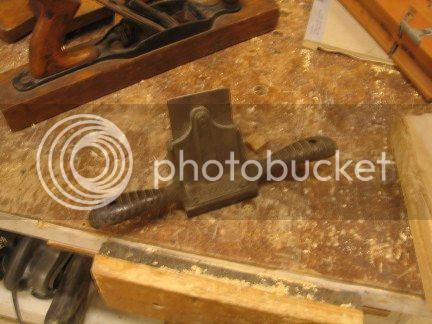kirkpoore1
Established Member
Last weekend while I had a gob of folks over at the house doing woodworking (see https://www.ukworkshop.co.uk/forums/a-weekend-in-the-factory-t55093.html), my wife and one of the other ladies went off to a local flea market--where they proceeded to buy up an example of every type of wood plane they could find. They both know their husbands do woodworking, so they thought they were doing us a favor. In truth, they were, but they were kind of cutting us out of some of the fun. Anyway, when they got back, we divided up the spoils. Here's my share:

From left to right, anonymous transitional jack plane ($20), coffin smoother ($5), round bottom ($10), hollow bottom($10), and an unusual two iron plane($10).
Here's the jack and the smoother:

The smoother has the original wedge, but somebody added a Stanley type iron and chip breaker. This one is in only fair shape, with some cracks in the sole. A cleanup might make a difference, but I don't think it's a user.
Hollow and round profiles:

Both of these are in really good shape. Not the same size, but both will be useful. I have a project with linenfold panels that I'll start next spring, and I expect to use both then.
Two iron plane profile:

I have no idea what this is for. At first I thought it might be some kind of window sash plane, but now I just don't know. The profile is quite shallow, and since there is no iron in the middle it can't go any deeper. The plane itself is in excellent shape. Anybody care to guess what this is for?
Finally, last month I picked up this Stanley 81 scraper:

Nickle plating is almost all gone, but the sole is in good shape. I use a card scraper a lot, so I expect this will get plenty of use once I take the time to sharpen it.
I'm not a big wooden plane user (except spokeshaves), but now I'm up to about a dozen and I'm going to have to do something with them.
Kirk

From left to right, anonymous transitional jack plane ($20), coffin smoother ($5), round bottom ($10), hollow bottom($10), and an unusual two iron plane($10).
Here's the jack and the smoother:

The smoother has the original wedge, but somebody added a Stanley type iron and chip breaker. This one is in only fair shape, with some cracks in the sole. A cleanup might make a difference, but I don't think it's a user.
Hollow and round profiles:

Both of these are in really good shape. Not the same size, but both will be useful. I have a project with linenfold panels that I'll start next spring, and I expect to use both then.
Two iron plane profile:

I have no idea what this is for. At first I thought it might be some kind of window sash plane, but now I just don't know. The profile is quite shallow, and since there is no iron in the middle it can't go any deeper. The plane itself is in excellent shape. Anybody care to guess what this is for?
Finally, last month I picked up this Stanley 81 scraper:

Nickle plating is almost all gone, but the sole is in good shape. I use a card scraper a lot, so I expect this will get plenty of use once I take the time to sharpen it.
I'm not a big wooden plane user (except spokeshaves), but now I'm up to about a dozen and I'm going to have to do something with them.
Kirk




